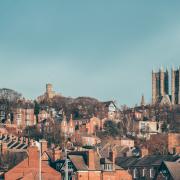Jo Haywood takes up where Mother Shipton left off to reveal why your future should include a visit to Knaresborough
Thousands of people visit the historic North Yorkshire market town of Knaresborough every year, but there’s always room for more.
Not content with relying on its quirky attractions, bustling market place and pretty riverside walks, the good people of this pleasantly eccentric place organise all manner of events to keep the town buzzing, themselves busy and the tills close to bursting point.
We’ve chosen few of the many good reasons to visit this lovely town, but if you’d like to add more to the list register and leave a comment below, tweet @Yorkshire_Life or write to Yorkshire Life, PO Box 163 Ripon, North Yorkshire, HG4 9AG. We’d love to hear from you.
Mother love
Knaresborough’s most infamous daughter – Mother Shipton – is still drawing the crowds many centuries after her death.
This petrifying Yorkshire witch prophesied future events in the form of poems, predicting the fates of several rulers, the invention of iron ships, the Great Fire of London, the defeat of the Spanish Armada and the end of the world (although she still might be proved wrong on that last one).
She could not have known, however, just how popular Mother Shipton’s Cave & Historic Park (mothershipton.co.uk) would be. Widely believed to be England’s oldest visitor attraction (it dates back to 1630), it continues to draw in the crowds with its eerie cave dwelling and unique petrifying well.
All manner of everyday objects have been turned to stone by the 3,200 litres of water that flow over the well every hour of every day, but the most popular items are teddy bears – what they’ve done to deserve such a fate isn’t clear – which take between three and five months to petrify.
And so to bed
The town’s annual bed race has become something of a phenomenon, attracting thousands of people every year (even Nessie turned up this time and she’s usually a bit of a recluse).
The unpredictable weather almost put a stop to last year’s event, but the 48th Great Knaresborough Bed Race went ahead on June 8th 2013 without a hitch, with huge crowds filling the streets to watch teams parading majestically (sort of) through the town centre to Conyngham Hall.
Harrogate Harriers won the race in just 13 minutes 10 seconds, with Ripon Runners for Girls screeching to a halt exactly three minutes later to scoop the title as fastest female team.
Nature calls
A new nature trail has just been launched in Knaresborough’s Jacob Smith Park (jacobsmithpark.org.uk), designed by ecologist Bernadette Lobo and artist Carline Miekina with help from Harrogate Borough Council, the Friends of the park and nearby Meadowside School.
‘This is a great new leisure activity for all ages to enjoy,’ said Patrick Kilburn, the council’s head of parks and open spaces. ‘Jacob Smith Park is a very interesting ancient parkland with plenty of plants and wildlife to spot, especially with the nature trail as a useful guide.’
The next organised event at the park is a series of bat walks (of the winged rather than wooden variety) on August 14th and 16th as part of the town’s Feva festivities.
By royal appointment
Knaresborough Castle, which stands towering over the River Nidd, was once a stronghold of medieval kings, but is now more likely to house ordinary peasant folk taking a tour of the King’s Tower, trotting through the secret underground exit (sallyport) and not lingering for too long in the dank dungeon.
The Courthouse Museum, located in one of the castle’s oldest surviving buildings, is also something of a tourist treasure as it gives an important glimpse into the town’s fascinating history and the colourful characters who have contributed to it.
Viaduct values
The viaduct spanning the River Nidd in Knaresborough must be one of the most photographed in Yorkshire. The 78ft high, gritstone Grade II listed bridge was opened in 1851 to carry Victorian rail traffic on the Leeds and Thirsk Railway over the Nidd Gorge. Work on the viaduct began in 1847 but the bridge collapsed in 1848 and it was completed at an extra cost of almost £10,000. And although it’s considered part of our transport heritage, Pevsner describes it architecturally as ‘one of the most notable railway crimes in England’. Do you have an opinion either way? We would love to hear from you. Email feedback@yorkshirelife.co.uk



























